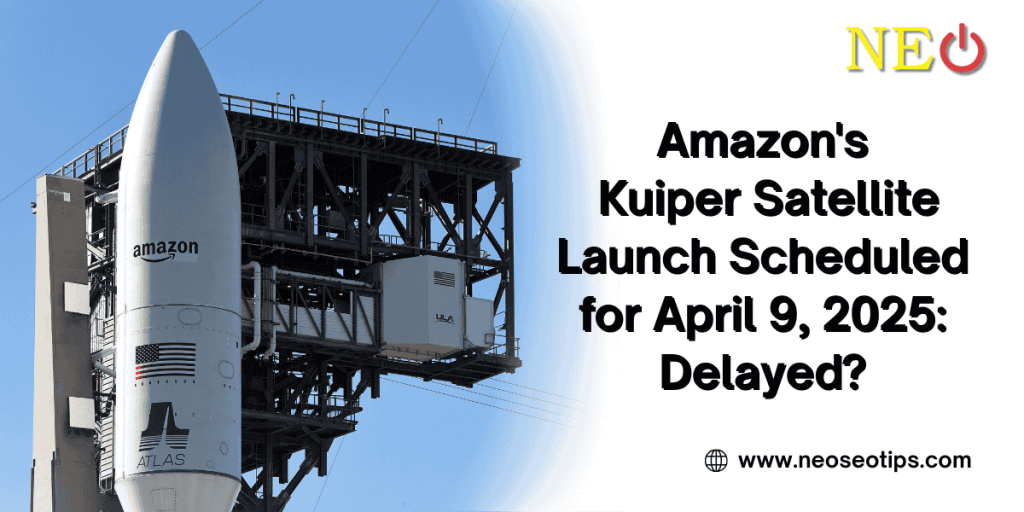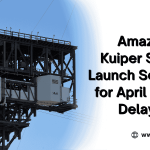Kuiper Satellite Launch: Amazon’s Ambitious Venture into Space Internet-
Envision a future where high-speed internet is accessible in every location, from busy urban areas to isolated communities. Amazon is making that dream a reality through its Project Kuiper, with a significant advancement occurring in April 2025 during the Kuiper Satellite Launch. This mission aims to deploy 27 satellites into orbit, marking Amazon’s initial significant effort to compete against SpaceX’s Starlink in the quest for dominance in satellite broadband. Let’s explore what is unfolding, the importance of this initiative, and what lies ahead for this revolutionary project.
Introducing Project Kuiper:
Project Kuiper represents Amazon’s bold initiative to provide affordable and dependable internet access across the globe through a network of satellites positioned in low Earth orbit. Envision it as a cosmic Wi-Fi network aimed at connecting those without internet access. With more than $10 billion invested, Amazon plans to launch 3,236 satellites to compete with Starlink's expanding fleet of over 8,000. The initial launch in April 2025 marks the beginning, demonstrating Amazon's commitment to entering the satellite internet sector.
Launch of the Kuiper Satellite reveals:
The Kuiper Satellite Launch was initially planned for April 9, 2025, at 7:00 PM EDT, departing from Cape Canaveral Space Force Station in Florida. The mission was to utilize a powerful Atlas V rocket from United Launch Alliance, equipped with five solid rocket boosters to carry the heaviest payload this rocket has ever delivered: 27 satellites intended for a 280-mile-high orbit. These satellites represent the first operational group, following two successful test satellites that were launched in 2023. However, weather conditions were unfavorable; rain, wind, and cloud cover necessitated a postponement, prompting the team to consider a new launch opportunity on April 10, 2025.
Innovative Satellites Fueling the Mission:
What sets these satellites apart? They are equipped with state-of-the-art technology. Phased array antennas provide quick, targeted internet signals, while optical connections enable communication between satellites in space, enhancing efficiency. Electric propulsion systems will gently navigate them to their designated 630-kilometer orbit. Additionally, they are covered with a reflective film to reduce their brightness, which is a plus for astronomers. This technology isn’t merely advanced it forms the foundation of Amazon’s commitment to offer low-latency broadband to millions.
Weather Obstacles and Preparing for Launch:
The postponed launch on April 9 came as no shock to space enthusiasts weather frequently disrupts plans. As of April 10, 2025, a new date has not yet been confirmed, but predictions suggest that better weather is on the horizon. This setback is merely a brief pause, not an end. Amazon and United Launch Alliance are prepared to proceed as soon as conditions are favorable, demonstrating that even major endeavors like Project Kuiper must yield to the forces of nature. For the time being, people around the globe are watching attentively, looking forward to the Atlas V's thunderous departure.
The Grand Plan: 3,236 Satellites and More:
- Launch Timeline: The Project Kuiper launch, set for April 2025, is just the beginning of Amazon’s ambitious satellite internet initiative.
- Satellite Deployment: It plans to deploy 3,236 satellites across three orbital layers at altitudes of 590, 610, and 630 kilometers.
- FCC Deadlines: The Federal Communications Commission mandates half the satellites be launched by July 2026, with all in orbit by July 2029.
- Launch Partnerships: Amazon has secured over 80 launches with partners like United Launch Alliance, Arianespace, Blue Origin, and SpaceX.
- Production & Goal: At its Kirkland facility, production is scaling to five satellites daily, aiming to provide global internet access, starting with underserved areas, businesses, and governments.
Starlink vs. Kuiper: The Internet Battle Intensifies-
SpaceX’s Starlink is currently ahead, boasting millions of subscribers and a multitude of satellites. However, Amazon is determined to compete. The Kuiper Satellite Launch puts Amazon into the spotlight, promising competition that could foster innovation and reduce prices. While Starlink is thriving, Kuiper’s emphasis on collaborations such as with Verizon and Vodafone might help it establish its unique position. This is more than a technological competition; it's a struggle to connect the globe, and Amazon is making a substantial effort to compete.
What’s Ahead for Project Kuiper?
If the launch in April is successful, Amazon will evaluate the data to enhance future missions, including the next set already scheduled for another Atlas V. Beta testing will commence in late 2025, providing internet access to initial customers. Picture rural schools streaming lessons or businesses in isolated regions participating in the digital economy all made possible by satellites launched this month. Project Kuiper has the potential to transform our perspective on internet access, making it as widespread as the stars overhead. For more updates, Stay Tuned!









